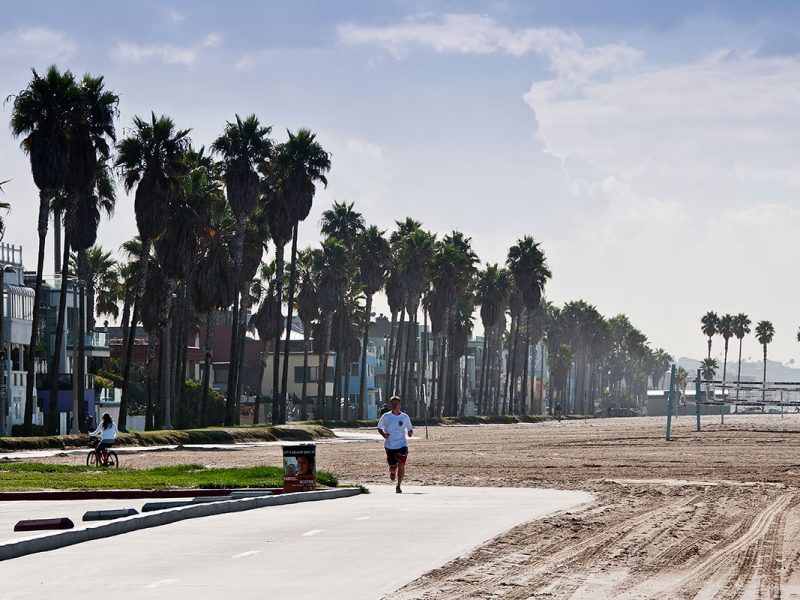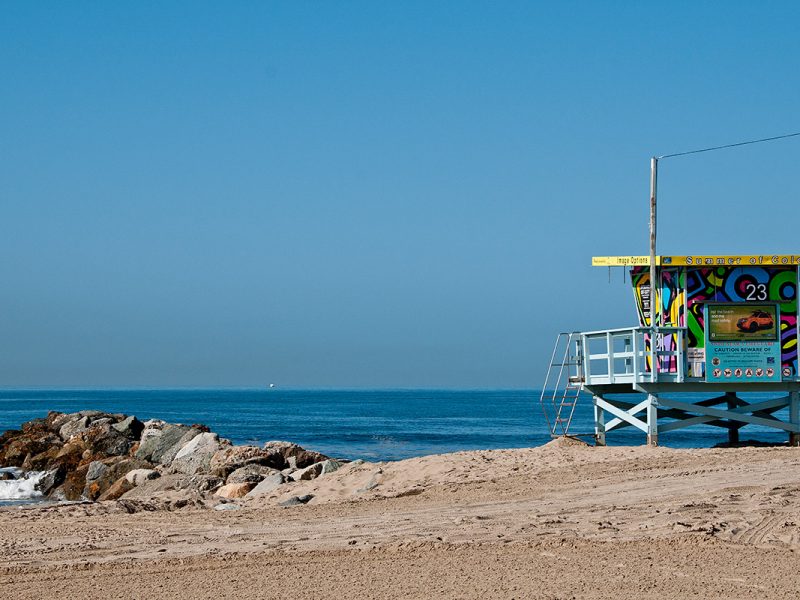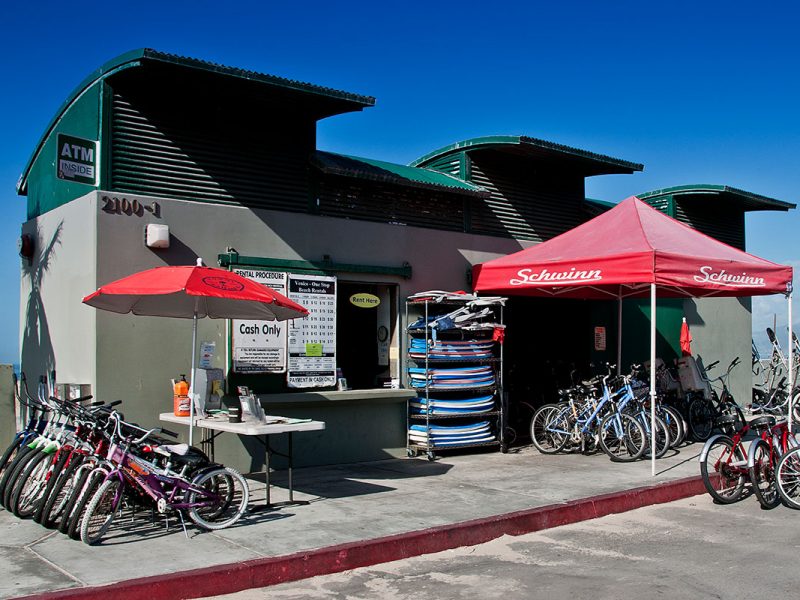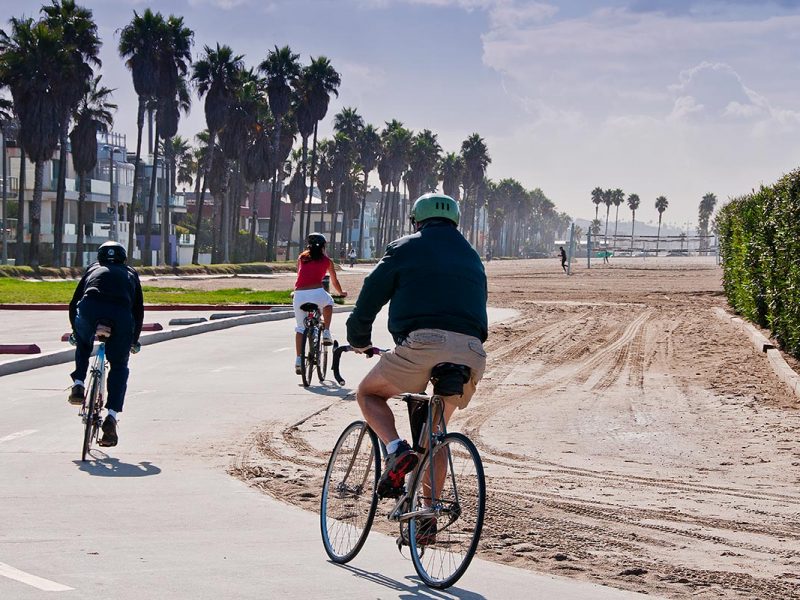LOS ANGELES COUNTY
VENICE BEACH
VISIT VENICE BEACH
Venice Beach has almost 3 miles of coastline with 238 acres of beach and 3 parking lots with over 1200 spaces. Venice Beach is understood to include the promenade that runs parallel to the beach (Ocean Front Walk), Muscle Beach, the tennis courts, Skate Dancing plaza, numerous volleyball courts, the bike trail, and of course the beach itself.
Venice Beach is one of the most interesting and popular sights in Los Angeles. Venice hosts artists, palm readers, bikini-clad roller skaters, belly dancers, vendors, street performers and of course bodybuilders. Legendary Muscle Beach is where former Governor Arnold Schwarzenegger and others bulked up in the workout pit.
The area is great for people watching as well as shopping and eating. There are various eateries along Ocean Front Walk. For those who are more inclined to actual beach activities, swimming, beach volleyball, fishing, and surfing are popular at this beach. The Venice Breakwater is actually an acclaimed local surf spot. Bike and skate rentals are also available along Ocean Front Walk.
VENICE BEACH SURF REPORT
Rotate Phone to View
BEACH HISTORY
Venice of America was founded in 1905 as a beach resort town by tobacco millionaire Abbot Kinney. Before 1900 Venice Beach was nothing but marshland. Abbot Kinney had the vision of turning the desolate marshland into a renaissance resort and amusement park. Kinney envisioned a resort town culturally reminiscent of Venice, Italy, complete with canals, gondolas, amusement piers, hotels and Venetian-styled structures. On July 4, 1905, Kinney hosted the grand opening of his resort town featuring yacht racing, swimming races in the lagoon, band concerts, fireworks at the 2,500 seat amphitheater, and of course the 16 miles of newly built canals. He even brought a dozen gondoliers from Europe to pole through his shiny new paradise.
Tourists were able to ride Venice’s miniature railroad and gondolas to tour the town. However, the biggest attraction was the mile-long gently sloping beach. Cottages and housekeeping tents were available for rent. Kinney also built a 1200-foot long pleasure pier with an auditorium, ship restaurant, and dance hall. Another main attraction of the pier was the salt-water plunge where visitors were given the choice of heated or ocean temperature bathing. The population grew quickly and drew 50,000 to 150,000 tourists on weekends, earning Venice the name “Playland of the Pacific.”
On November 4, 1920, Abbot Kinney died, leaving his eldest son to take over the business. One month later, his amusement pier burned to the ground, sparing only a couple of attractions. It was rebuilt and operating six months later. However, in 1924 the pier suffered another devastating fire that destroyed the entire complex.
By 1925, Venice’s politics became unmanageable. The roads, water, and sewage systems were in need of much repair and expansion to keep up with its growing population. That same year Venice was annexed to Los Angeles through a special election and officially became a part of the city in October 1925.
The City of Los Angeles began to dismantle the amusement industry that Venice was known for. It removed the miniature railroad and filled the majority of the canals to accommodate increased automobile traffic. In 1929, oil was discovered and within two years 450 oil wells covered the area. The drilling waste clogged the remaining waterways. Only the canals south of Venice Boulevard remained intact. The city also wanted to close Venice’s three amusement piers but had to wait until the leases expired in 1946.
World War II affected Venice and its seaside amusement centers. Blackouts were instituted, which only allowed daytime use of the piers and their attractions. National Guardsmen frequently patrolled the beaches in search of enemy submarines and ships.
During the day, Venice became a major draw for sailors and soldiers on weekend leave. Life at Venice Beach did not return to normal until 1944, when the curfews were finally lifted. The City of Los Angeles had neglected Venice so long that by the 1950’s it had become known as the “Slum of the Sea.” With the exception of new police and fire stations in 1930, the city spent little on improvements after annexation. Cheap rents for run-down bungalow housing attracted predominantly European immigrants, young counterculture artists, poets, and writers. By the end of the 1950’s pawnshops and liquor stores had replaced the souvenir shops and bingo parlors that had attracted tourists to the area.
Venice was in a severe state of decay and in need of redevelopment. In the early 1960’s the city instituted a policy of code enforcement, which required the upgrading of all buildings to the current building standards. The city made it impossible for owners to obtain loans, and eventually 550 buildings were demolished paving the way for new construction.
Venice always attracted whatever the counterculture of the decade was, be it the 50’s Beat generation, the hippies of the 60’s or the New Agers of the 70’s and 80’s. Despite its ups and downs throughout the years, Venice Beach is once again a magnet for tourists.
Venice is the place that generates the image of the freewheeling, laid-back, eccentric and slightly crazed, yet creative and cutting edge city that many people envision Los Angeles to be.





